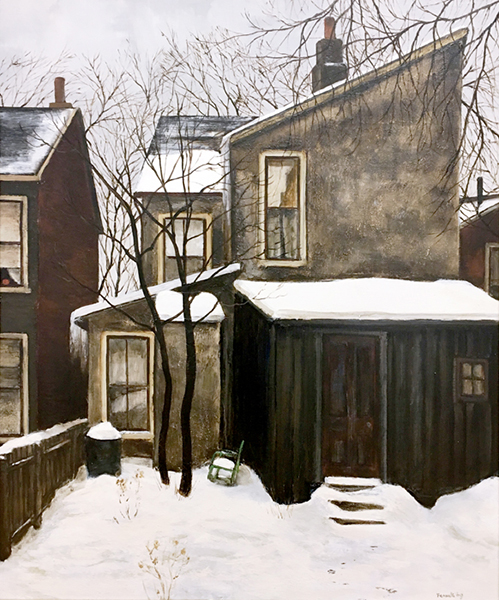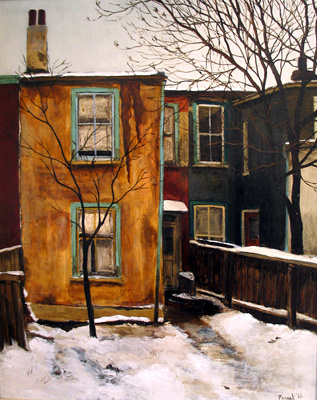Albert Franck
Albert Jacques Franck (1899-1973) – Artist Biography
Born at Middelburg, Holland, Albert Jacques Franck was interested in art from an early age but his father discouraged him from becoming an artist and consequently he did not begin to paint until after his arrival in Canada in 1926 following a series of ventures in Indonesia, California, and the winning of a national swimming championship in Belgium. He worked as a swimming instructor at the Central YMCA in Montreal and at Jasper Park and elsewhere. He had musical training as a boy and played the cello. Through his interest in swimming and music he met his artist wife, Florence Vale. During his first year in Canada he began to paint and did street scenes as early as 1928. In the late 1920’s he worked in the fine art department of Simpson’s store in Toronto. With the market crash of 1929 he lost his job. Nine bad years followed but in 1940 he established himself in the picture restoring business and made his living as a painter under the title of Picture Restorer. In 1947 he had begun solo shows first at Simpson’s and Eaton’s (1947-50); Roberts Gallery, Tor. (1957) (1960); Hart House, Tor. (1958); Galerie Moos (1960) and York U. (1963) and elsewhere.
Reviewing his work in April of 1964, Harold Town wrote, “. . . . His success is based firmly in reality, the reality of his talent. Not long ago though, at the beginning of his recognition for the thing he does best, he embarked on a series of paintings of Canada seen from the air. They failed mainly because Franck, a great host, and lover of food, women, dogs, cats, birds, snow, and urban congestion, was unable to establish an intense relationship with clouds and the essentially abstract experience of the air. Despite this he returned to his streets with new vigour and greater powers of architectonic organization . . . . Franck is now at the height of his powers, and must rank with the country’s best realists, but as a painter of urban streets it seems to me that he has no peers, past or present . . . .” His shows were usually a sellout and there was a waiting list for his paintings. He is represented in the following collections: AGO, Tor.; UWO, Lond., Ont.; U. of Guelph; J. Grant Glassco (Trustee, NGC), the late Robertson Davies; and in many other collections in Canada, U.S.A., Great Britain, the Netherlands, Rome, Mexico, Australia and New Zealand. He died in Toronto in 1973 at the age of 74. Affiliations: CSPWC, OSA, ARCA (1961-70).
Key Solo Exhibitions:
Simpsons, 1947 - 1950
Eaton’s Gallery, 1947 - 1950
Roberts Gallery (one man shows from 1950 – 1970s)
Hart House, 1958
Gallery Moos, 1960
Retrospective, Art Gallery of Ontario, 1973
Selected Permanent Collections:
Art Gallery of Ontario, Toronto
University of Western, ON
York University, Toronto ON
St. Hilda's College, Toronto
Kitchener Waterloo Gallery
Art Gallery of Hamilton, ON
Toronto Dominion Bank
Imperial Oil Ltd.
Shell Oil Co.
Toronto Stock Exchange
Royal Bank of Canada
University College, University of Toronto, ON
University of Guelph
Artist Specialization: Franck's subjects were old houses, usually in Toronto. With his camera he took many pictures, choosing the best for his sketch (slightly different from the actual photograph), from which he then made the larger finished painting (altered again from the sketch). He worked in all painting media. Harold Town, in his 1974 book Albert Franck – Keeper of the Lanes said that Franck was “a meat and potatoes painter whose work tasted like caviar.” Town and many of his famous contemporaries were directly influenced by Franck’s work and by his example of independence. Town wrote: “What makes Albert Franck’s contribution unique is the fact that he was not pursuing the barbarians of the new or defending the crusty antiquarians of the old, he was following his heart.”




